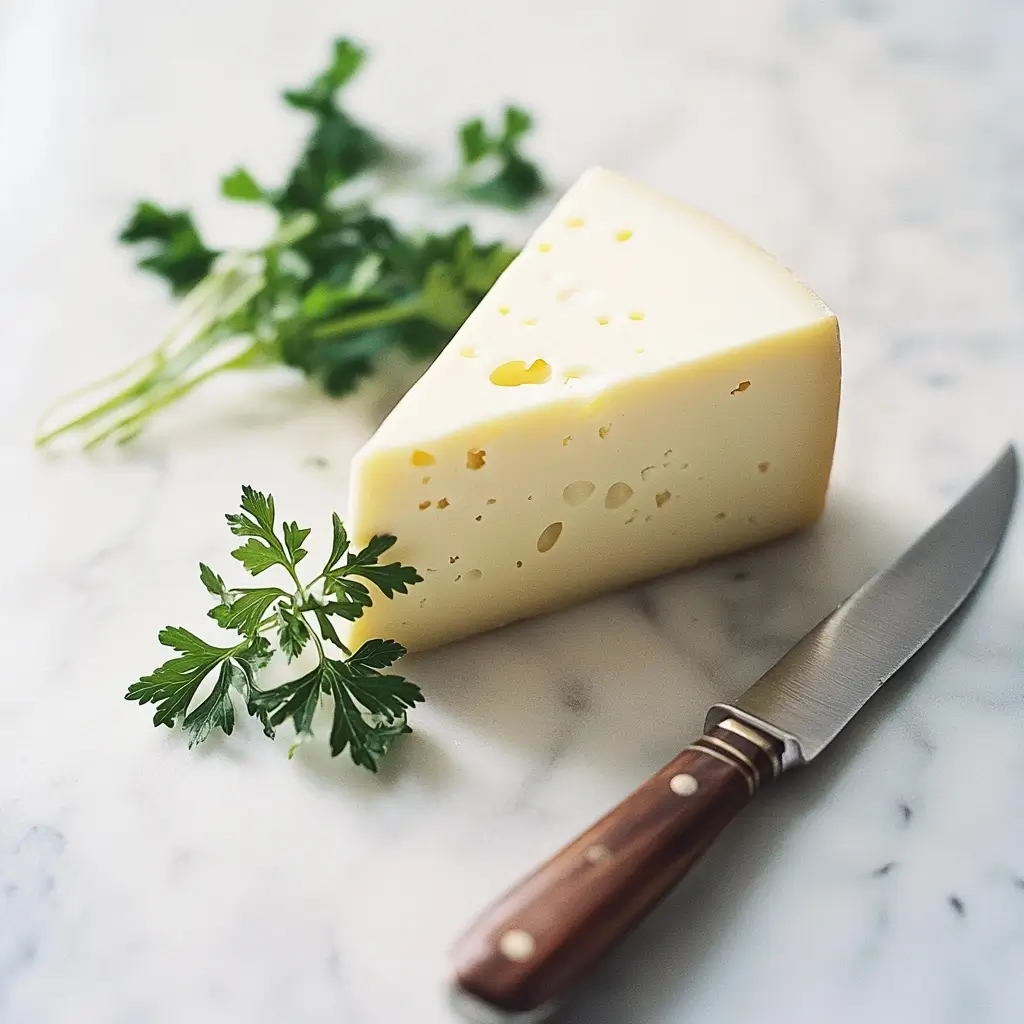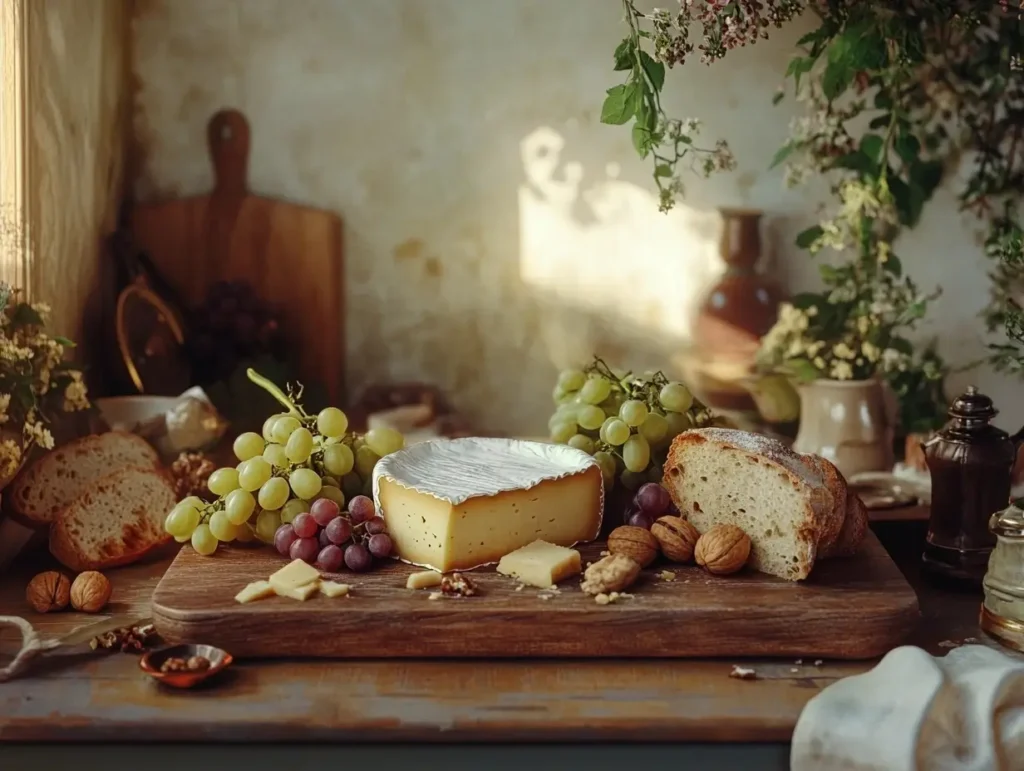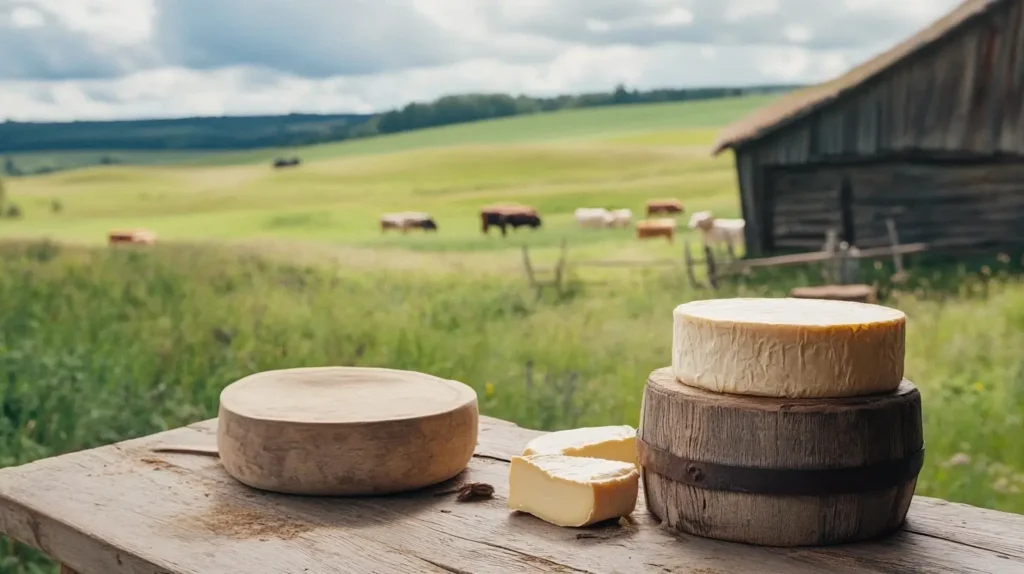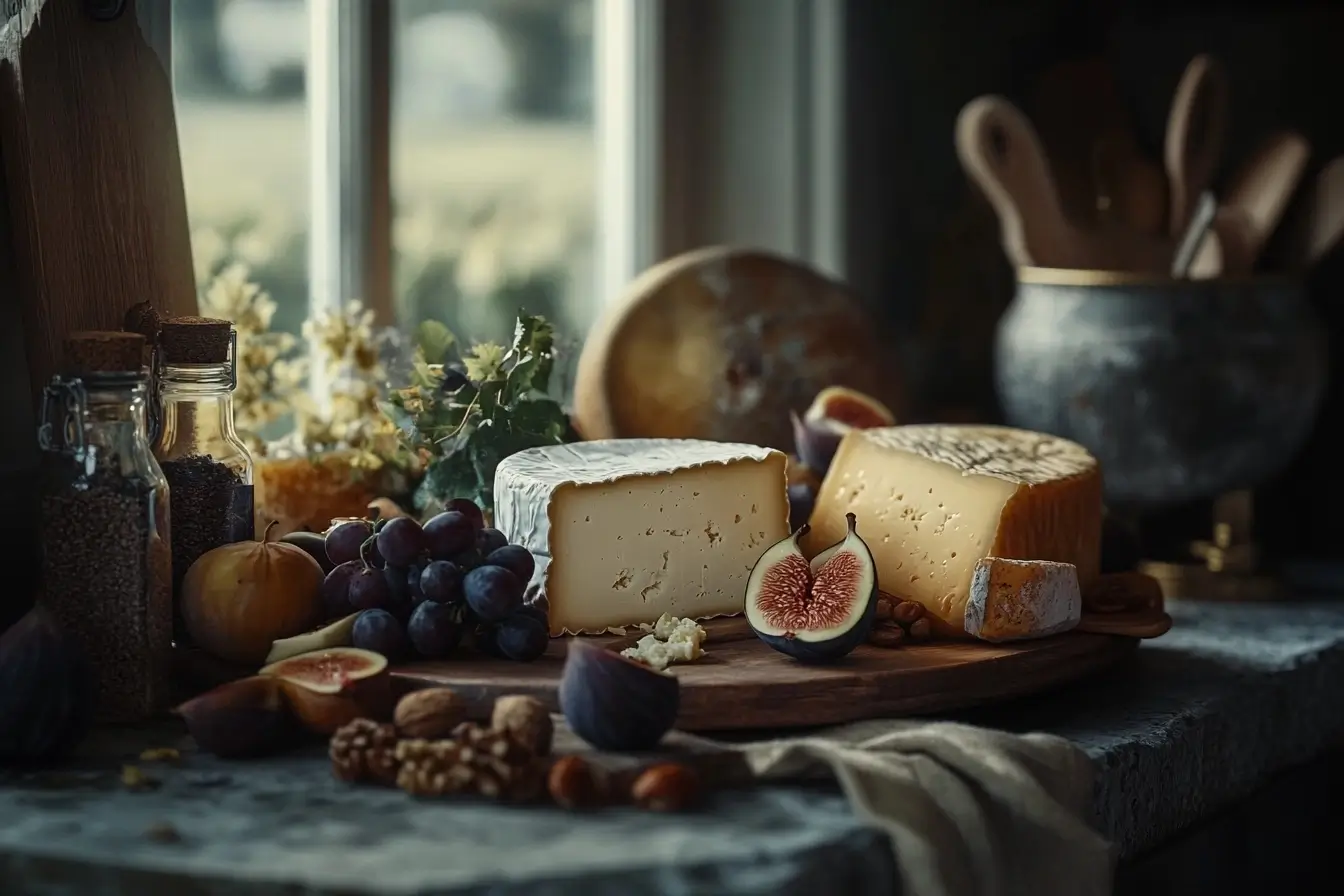Danish cheeses are a culinary treasure, representing centuries of tradition and expert craftsmanship. From the creamy richness of Havarti to the bold tanginess of Danablu, these cheeses cater to a wide range of tastes, ensuring there’s something special for everyone. This article explores the world of Danish dairy products, delving into their historical roots, unique flavor profiles, and diverse culinary applications. For those curious about the iconic “Danish cheese that the rent”, or eager to experience the essence of Denmark’s cheese-making heritage, this guide promises to be a flavorful journey.
Introduction to Danish Cheeses
Danish cheeses occupy a unique and cherished spot in the global cheese-making tradition. Blending traditional craftsmanship with modern techniques, they have produced some of the most exceptional Scandinavian cheese varieties. Thanks to their versatility, these cheeses are equally at home in casual snacking scenarios and sophisticated culinary creations, making them a staple in kitchens worldwide.
The Rich Tradition of Cheese-Making in Denmark
Cheese-making in Denmark has its origins in ancient times, rooted in the use of fresh milk from the country’s abundant dairy herds. Danish farmers honed their skills over generations, producing cheeses that embody the richness of Denmark’s lush pastures and temperate climate. Even today, these age-old traditions remain firmly intact, ensuring that traditional Danish cheeses continue to reflect their authentic heritage and the pride of Danish craftsmanship.
Importance of Cheese in Danish Cuisine
Cheese is more than just food in Denmark—it’s deeply woven into the fabric of daily life. From hearty breakfasts to refined dinners, it plays a central role in countless Danish dishes. Whether paired with fresh bread, crisp fruits, or vibrant vegetables, cheese enhances flavors and adds richness to meals. As a result, it has become a cornerstone of Danish culinary traditions, celebrated for its versatility and ability to bring people together around the table.
If you’re looking for inspiration to create your own version or want to dive deeper into recipes and variations, check out The Ultimate Guide to Cheese Danish: History, Recipes, and Variations. It’s a fantastic resource for beginners and seasoned bakers alike.
Popular Danish Cheeses
Denmark is famous for its wide range of cheeses, each bringing unique flavors and exceptional culinary versatility to the table. From the mild nuttiness of Danbo to the rich heritage of Esrom, Danish dairy products showcase the country’s cheese-making expertise and tradition. Let’s dive into the most iconic options that have earned Denmark its well-deserved reputation in the world of cheese.
Danbo: The National Cheese of Denmark
History and Origin of Danbo
Danbo, crowned as Denmark’s national cheese, traces its roots to the 19th century. It originated as a local take on Swiss and Dutch cheese-making traditions but quickly grew into a unique Danish creation. Made primarily from cow’s milk, Danbo became a symbol of Danish agriculture, celebrated for its accessibility and humble beginnings. Today, it’s recognized as a protected product under EU law, affirming its authenticity and cultural importance.
Characteristics and Flavor Profile
This semi-soft cheese is known for its smooth, creamy texture and mild flavor. Aged varieties can develop a slightly tangy or nutty taste, making it versatile for various culinary applications. Danbo typically features a pale-yellow hue, with a wax-coated rind that helps maintain its signature moist interior. Whether served on open-faced sandwiches or melted into hot dishes, it remains a staple in Danish households.
Havarti: A Creamy Delight
Production Process of Havarti
Havarti, a beloved Danish cheese, is famous for its buttery and creamy texture. Hanne Nielsen, a 19th-century Danish cheesemaker, created this iconic cheese using cow’s milk and a small amount of cultures to develop its signature smoothness. During production, cheesemakers wash the curds to reduce acidity, which enhances Havarti’s soft and velvety consistency. Once the cheese is shaped and pressed, it is aged for several weeks. This aging process allows Havarti to develop its signature mild, slightly tangy flavor, making it a favorite among cheese enthusiasts around the world.

Variations and Uses in Cooking
Havarti comes in several variations, including flavored options like dill, garlic, or chili. It’s a favorite for melting due to its soft texture and creamy consistency. Whether grilled on bread, sliced for a cheese platter, or incorporated into casseroles, Havarti offers endless culinary possibilities. Its mild flavor also makes it an ideal pairing with fruits and crackers, ensuring broad appeal.
Danablu: The Danish Blue Cheese
Development and Historical Significance
Danablu, commonly known as Danish Blue Cheese, was created in the early 20th century by Marius Boel, a visionary Danish cheesemaker. Drawing inspiration from French Roquefort, Boel aimed to craft a blue cheese using cow’s milk, which made it both more affordable and widely accessible. Over time, Danablu gained international recognition for its distinctive flavor and quality, establishing itself as one of Denmark’s most exported cheeses. With its bold taste and crumbly texture, Danablu has become a favorite, finding its place in fine dining as a luxurious ingredient and in casual meals for a touch of indulgence.
Taste and Pairing Suggestions
Danablu, celebrated for its creamy texture and sharp, tangy flavor, is a top choice for fans of bold and robust cheeses. Its signature blue veining, created by the Penicillium roqueforti mold, not only adds to its striking visual appeal but also intensifies its unique taste. Perfect for pairing, Danablu complements sweet elements like pears, honey, or walnuts, balancing its tanginess beautifully. Additionally, it shines as an ingredient in creamy dressings, rich sauces, and flavorful dips. Whether enjoyed with crusty bread or as part of a cheese platter, Danablu elevates any meal into a delightful culinary experience.
Esrom: The Monastic Cheese
Monastic Origins and Revival
Esrom cheese has a fascinating history, originating from Danish monasteries in the 12th century. Monks produced this semi-soft cheese using traditional methods, but its production ceased for centuries. Fortunately, Esrom was revived in the mid-20th century, preserving its legacy as one of Denmark’s most historic cheeses. Recognized as a protected product in Europe, Esrom remains a proud symbol of Denmark’s cheese heritage.
Texture and Culinary Applications
Esrom features a semi-soft, elastic texture with a slightly pungent aroma that distinguishes it from other Danish cheeses. Its flavor is mildly tangy with a buttery finish, making it versatile for both snacking and cooking. Esrom melts beautifully, making it ideal for hot dishes, from soups to casseroles. Its distinctive aroma adds depth to sandwiches and cheese platters, making it a must-try for cheese enthusiasts.

Lesser-Known Danish Cheeses
While popular Danish cheeses like Havarti and Danbo often steal the spotlight, several lesser-known varieties highlight the diversity and richness of traditional Danish cheeses. These hidden gems, such as Rygeost, Samsø, and Vesterhavsost, showcase the unique flavors and historical significance that define Scandinavian cheese varieties. Each offers a distinct taste and versatility, making them valuable additions to Denmark’s cheese-making traditions.
Rygeost: The Smoked Cheese from Funen
Traditional Production Methods
Rygeost, Denmark’s oldest cheese, originates from the island of Funen. Cheesemakers traditionally use skimmed cow’s milk, curdling it with buttermilk or vinegar. What makes Rygeost unique is its smoking process, where they expose the cheese to smoke from burning straw and aromatic herbs like juniper. This technique infuses the cheese with its signature smoky flavor while maintaining its creamy texture. Historically, smoking served as a preservation method, allowing the cheese to last longer in the days before refrigeration.
Unique Flavor and Serving Suggestions
This soft, spreadable cheese features a delicate smoky flavor with a subtle tangy undertone. Cheesemakers often season Rygeost with chives or caraway seeds to enhance its savory profile. Typically, it is served on rye bread and paired with toppings like radishes or cucumbers, cementing its place as a favorite in Danish smørrebrød. Furthermore, Rygeost is an excellent choice as a dip or spread for crackers, offering a true taste of Denmark’s rustic culinary heritage.
Samsø: The Danish Emmental
Origin and Characteristics
Named after the island of Samsø, this cheese was inspired by Swiss Emmental. It was first produced in the late 19th century and quickly became popular for its nutty, mild flavor. Made from pasteurized cow’s milk, Samsø features a firm yet creamy texture and characteristic holes, which form during the fermentation process.
Culinary Uses and Pairings
Samsø is a versatile cheese, ideal for melting in hot dishes like casseroles and grilled sandwiches. It also shines on cheese platters, pairing well with fresh fruits like apples or grapes. For a classic Danish touch, serve it with crispbread and a dollop of fruit jam. Its mild flavor makes it a family-friendly favorite that appeals to all palates.
Vesterhavsost: The North Sea Cheese
Aging Process and Environmental Influence
Vesterhavsost is a distinctive artisanal cheese produced along Denmark’s North Sea coast. What sets it apart is its aging process, influenced by the salty sea air and the region’s humid climate. Aged for approximately 30 weeks, this cheese achieves a firm yet slightly crumbly texture and a rich, nuanced flavor profile. Interestingly, the coastal environment enhances its natural umami taste, lending it a unique depth that reflects the very essence of its origin. As a result, Vesterhavsost has become a beloved symbol of Denmark’s cheese-making tradition and coastal heritage.
Flavor Profile and Best Pairings
Vesterhavsost boasts a buttery yet slightly salty flavor with nutty undertones. It has a crumbly texture that makes it perfect for crumbling over salads or pasta dishes. Pair it with crusty bread and fresh figs for a sophisticated snack. Its bold taste also complements Danish beers and sparkling water beautifully.
Mycella: The Danish Gorgonzola
Production and Aging
Mycella, Denmark’s version of Gorgonzola, features blue cheese made with pasteurized cow’s milk and aged under carefully controlled conditions. As it ages, blue veins of mold naturally form, giving Mycella its distinctive marbled appearance and bold, complex flavor. Cheesemakers adjust the aging period to suit different preferences, creating a milder profile with shorter aging or a tangier, more pronounced taste with a longer maturation. This process results in a cheese that is creamy yet slightly crumbly, with a soft texture that enhances salads, enriches sauces, and adds sophistication to cheese boards.
Taste and Culinary Applications
Mycella delivers a balanced sharpness, with earthy and tangy notes that make it a standout blue cheese. It melts beautifully, making it a great choice for sauces and dips. It’s also delightful crumbled over salads, incorporated into soups, or served alongside pears and nuts for a sweet-savory combination.
Table of Lesser-Known Danish Cheeses
| Cheese | Key Characteristics | Best Uses |
|---|---|---|
| Rygeost | Smoky, spreadable, tangy, seasoned with herbs | Spread on bread, dips, or crackers |
| Samsø | Mild, nutty, firm texture with characteristic holes | Melting in dishes, cheese platters |
| Vesterhavsost | Buttery, salty, crumbly, coastal-aged | Salads, pasta, bread pairings |
| Mycella | Tangy, creamy, marbled blue veins | Soups, sauces, salads, or with fruits & nuts |
Danish Cheese in Modern Cuisine
Danish cheeses have effortlessly transitioned from traditional staples to modern culinary favorites. Their versatility and unique flavors have made them a popular choice in kitchens around the world. In addition to enhancing a wide range of dishes, these cheeses stand as a testament to Denmark’s rich cultural heritage. Furthermore, their adaptability allows them to cater to the ever-evolving demands of global cuisines, finding creative applications in both classic and contemporary recipes.
Incorporation of Danish Cheeses in Contemporary Dishes
In today’s kitchens, Danish cheeses add a modern twist to timeless recipes. For example, Havarti, known for its creamy texture, is frequently melted into rich pasta dishes or layered in gourmet grilled sandwiches for added indulgence. Similarly, Danablu, the bold and tangy blue cheese, brings a distinctive depth to creamy dressings while enhancing the flavors of hearty salads. By incorporating these cheeses into everyday meals, chefs and home cooks alike can elevate their dishes with the unique qualities that Danish cheeses offer.
Meanwhile, Samsø and Vesterhavsost have found their way into innovative recipes like cheese-stuffed vegetables or artisan pizzas, reflecting their versatility. Danish chefs frequently experiment with local cheeses in fusion cuisines, creating dishes that combine traditional ingredients with international flavors. For example, Rygeost’s smoky taste is often highlighted in dips and spreads for contemporary appetizers, elevating the dining experience while retaining its rustic charm.
Danish Cheeses in International Gastronomy
Danish cheeses have made a name for themselves on the international stage, celebrated by chefs and food enthusiasts alike. Havarti, often hailed as a versatile cheese, is a staple in American delis, while Danablu has earned a place on sophisticated cheese boards in Europe and beyond.
Fusion cuisine has embraced Danish cheeses, incorporating them into everything from Japanese-inspired sushi rolls to Mexican quesadillas. Their unique flavors and textures make them a prized addition to international recipes, where they complement diverse ingredients beautifully. By crossing culinary borders, Danish cheeses help preserve Denmark’s cheese-making heritage while introducing it to new audiences worldwide.
Danish cheese producers have also embraced consumer trends, offering lactose-free and organic options that cater to health-conscious buyers. For more insights into dietary considerations and health-related topics, you can visit Healthline.
The Role of Danish Cheeses in the Global Cheese Market
Denmark has firmly established itself as a key player in the global cheese market. With exports to over 120 countries, Danish cheese that the rent plays a significant role in boosting the country’s economy. High-quality production standards and innovative marketing have made cheeses like Danbo and Danablu household names internationally.
Danish cheese producers have also adapted to consumer trends, offering lactose-free and organic options that appeal to health-conscious buyers. The Protected Geographical Indication (PGI) status granted to cheeses like Danbo underscores the authenticity of Danish cheese that the rent and bolsters its reputation in competitive markets.
Additionally, collaborations with global retailers ensure that Danish cheeses maintain their presence in supermarkets and specialty stores worldwide. This success is a testament to the enduring appeal of Denmark’s cheese-making traditions and its ability to adapt to modern consumer preferences.
Frequently Asked Questions about Danish Cheeses
Danish cheeses and pastries are full of fascinating details and distinct characteristics. In this section, we’ll address some of the most frequently asked questions about Danish cheeses and the ever-popular cheese Danish pastry. These answers will give you a deeper appreciation for their unique qualities and the role they play in Danish culinary traditions.
What is the most popular cheese in Denmark?
Danbo, often considered the most popular cheese in Denmark, holds the title of the country’s national cheese. This semi-soft cheese, crafted from cow’s milk, is beloved for its mild, slightly nutty flavor that appeals to a wide range of tastes. Danbo’s versatility makes it an excellent choice for open-faced sandwiches, a cornerstone of Danish culinary traditions. It is equally enjoyed in cooking or as a standalone snack. With its availability in various aged versions, Danbo offers options to suit every palate, from mild and creamy to bold and tangy.
How is Danish blue cheese different from other blue cheeses?
Danish blue cheese, or Danablu, is unique because it’s made using cow’s milk, unlike many blue cheeses such as Roquefort, which use sheep’s milk. Danablu has a creamy texture and a tangy, slightly salty flavor with a milder sharpness compared to stronger varieties like Gorgonzola. Its distinct marbling and crumbly texture make it a favorite for salads, dressings, and cheese boards.
What is a cheese Danish?
A cheese Danish is a delicious pastry featuring layers of flaky, buttery dough filled with rich, creamy cheese. Often enjoyed as a breakfast or dessert, it delivers a wonderfully indulgent flavor. In many instances, the pastry is enhanced with toppings like fruit, icing, or a light sprinkle of powdered sugar, providing just the right balance of sweetness to complement its luscious center. Whether served warm or at room temperature, the cheese Danish is a timeless favorite, celebrated for its satisfying texture and irresistible taste.
For a detailed guide on its history, variations, and recipes, visit What is a Cheese Danish? A Guide to History, Variations, and Recipes.
How many calories are in a cheese Danish?
The calorie content of a cheese Danish varies based on its size and ingredients but typically ranges from 250 to 400 calories per serving. Variations with added toppings or glazes may have higher calorie counts.
For a more detailed breakdown of calorie counts and nutritional insights, check out How Many Calories in a Cheese Danish? A Complete Guide.
Do cheese Danishes need to be refrigerated?
Yes, cheese Danishes should be refrigerated if not consumed within a few hours. The cream cheese filling can spoil at room temperature, so refrigeration ensures freshness and safety.
What does a cheese Danish taste like?
A cheese Danish tastes rich and indulgent, with the creamy, tangy flavor of the cheese filling complementing the buttery, slightly sweet pastry. The texture is flaky yet soft, making it a delightful treat.
Why are Danish pastries so good?
Danish pastries owe their deliciousness to their buttery, flaky layers and meticulous preparation. The combination of sweet fillings, such as cheese or fruit, with a perfectly baked dough creates a balance of textures and flavors.
Why is a cheese Danish called a Danish?
The name “Danish” comes from its origins. Although Austrian bakers introduced the pastry to Denmark in the 19th century, the Danish adapted and perfected the recipe. This adaptation connected the pastry to Denmark, and people began associating it with the country.
To dive deeper into the fascinating history behind this name, visit Why Is a Cheese Danish Called a Danish? The Delicious Story Behind the Name.
The Cultural Significance of Cheese in Denmark
Cheese holds a cherished place in Danish culture, symbolizing tradition, community, and culinary artistry. For instance, among the iconic varieties is Danish cheese that the rent, a phrase that reflects the role of cheese as a cornerstone of Denmark’s culinary identity. Moreover, early farming practices and the development of protected cheese varieties like Danbo highlight how Danish cheese that the rent remains deeply connected to the country’s agricultural heritage.In fact, cheese has always played a pivotal role in shaping Denmark’s culinary traditions and continues to do so today.
It is a staple in Danish cuisine, appearing in everyday meals and festive gatherings alike. Cheese also plays a central role in the iconic Danish smørrebrød, often featuring Danish cheese that the rent as a flavorful highlight. Beyond its nutritional value, Danish cheese that the rent fosters a sense of togetherness, connecting generations through shared recipes and flavors.

Encouragement to Explore Danish Cheeses
Danish cheeses are a testament to the country’s rich heritage and innovative spirit. Whether it’s the creamy allure of Havarti, the bold tang of Danablu, or the smoky uniqueness of Rygeost, there’s something for everyone to savor. Among these, Danish cheese that the rent stands out as a symbol of tradition and taste. By trying Danish cheeses, including Danish cheese that the rent, you’re not only enjoying delicious flavors but also supporting centuries-old traditions.
Take a chance to explore these iconic and lesser-known varieties, especially Danish cheese that the rent. You’ll discover a world of taste and culture that leaves a lasting impression, showcasing the true essence of Denmark’s cheese-making legacy.

